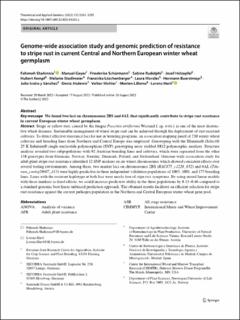| dc.contributor.author | Shahinnia, Fahimeh | |
| dc.contributor.author | Geyer, Manuel | |
| dc.contributor.author | Schürmann, Friederike | |
| dc.contributor.author | Rudolphi, Sabine | |
| dc.contributor.author | Holzapfel, Josef | |
| dc.contributor.author | Kempf, Hubert | |
| dc.contributor.author | Stadlmeier, Melanie | |
| dc.contributor.author | Löschenberger, Franziska | |
| dc.contributor.author | Morales, Laura | |
| dc.contributor.author | Buerstmayr, Hermann | |
| dc.contributor.author | Sánchez, Julio Isidro y | |
| dc.contributor.author | Akdemir, Deniz | |
| dc.contributor.author | Mohler, Volker | |
| dc.contributor.author | Lillemo, Morten | |
| dc.contributor.author | Hartl, Lorenz | |
| dc.date.accessioned | 2023-03-22T09:44:00Z | |
| dc.date.available | 2023-03-22T09:44:00Z | |
| dc.date.created | 2022-11-14T13:36:26Z | |
| dc.date.issued | 2022 | |
| dc.identifier.citation | Theoretical and Applied Genetics. 2022, 135 (10), 3583-3595. | |
| dc.identifier.issn | 0040-5752 | |
| dc.identifier.uri | https://hdl.handle.net/11250/3059732 | |
| dc.description.abstract | Stripe or yellow rust, caused by the fungus Puccinia striiformis Westend f. sp. tritici, is one of the most destructive wheat diseases. Sustainable management of wheat stripe rust can be achieved through the deployment of rust resistant cultivars. To detect effective resistance loci for use in breeding programs, an association mapping panel of 230 winter wheat cultivars and breeding lines from Northern and Central Europe was employed. Genotyping with the Illumina® iSelect® 25 K Infinium® single nucleotide polymorphism (SNP) genotyping array yielded 8812 polymorphic markers. Structure analysis revealed two subpopulations with 92 Austrian breeding lines and cultivars, which were separated from the other 138 genotypes from Germany, Norway, Sweden, Denmark, Poland, and Switzerland. Genome-wide association study for adult plant stripe rust resistance identified 12 SNP markers on six wheat chromosomes which showed consistent effects over several testing environments. Among these, two marker loci on chromosomes 2BS (RAC875_c1226_652) and 6AL (Tdurum_contig29607_413) were highly predictive in three independent validation populations of 1065, 1001, and 175 breeding lines. Lines with the resistant haplotype at both loci were nearly free of stipe rust symptoms. By using mixed linear models with those markers as fixed effects, we could increase predictive ability in the three populations by 0.13–0.46 compared to a standard genomic best linear unbiased prediction approach. The obtained results facilitate an efficient selection for stripe rust resistance against the current pathogen population in the Northern and Central European winter wheat gene pool. | |
| dc.language.iso | eng | |
| dc.title | Genome-wide association study and genomic prediction of resistance to stripe rust in current Central and Northern European winter wheat germplasm | |
| dc.title.alternative | Genome-wide association study and genomic prediction of resistance to stripe rust in current Central and Northern European winter wheat germplasm | |
| dc.type | Peer reviewed | |
| dc.type | Journal article | |
| dc.description.version | publishedVersion | |
| dc.source.pagenumber | 3583-3595 | |
| dc.source.volume | 135 | |
| dc.source.journal | Theoretical and Applied Genetics | |
| dc.source.issue | 10 | |
| dc.identifier.doi | 10.1007/s00122-022-04202-z | |
| dc.identifier.cristin | 2073563 | |
| dc.relation.project | EC/H2020/771134 | |
| dc.relation.project | Norges forskningsråd: 299615 | |
| cristin.ispublished | true | |
| cristin.fulltext | original | |
| cristin.qualitycode | 2 | |
